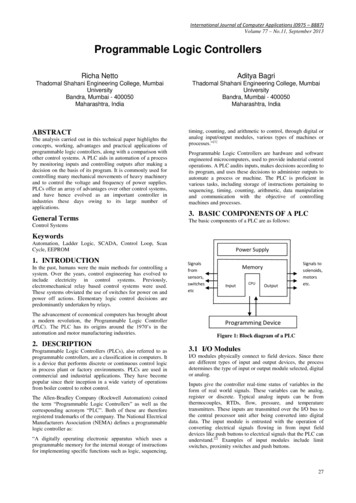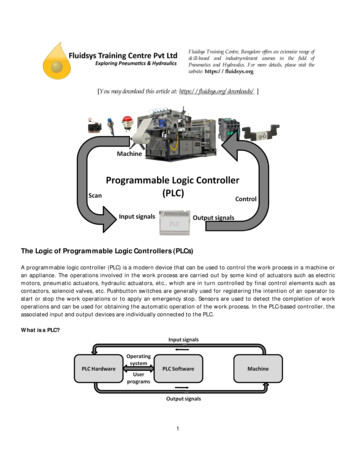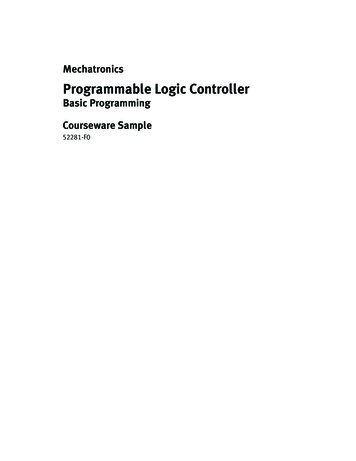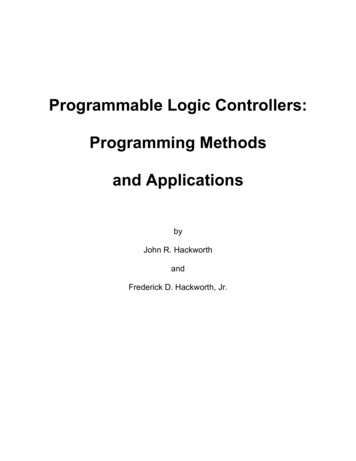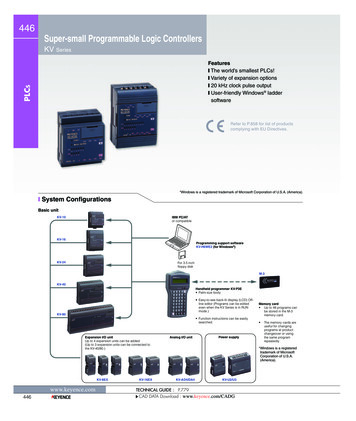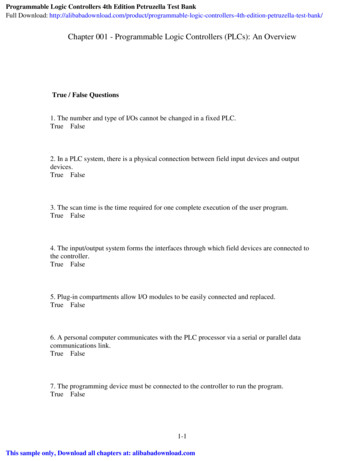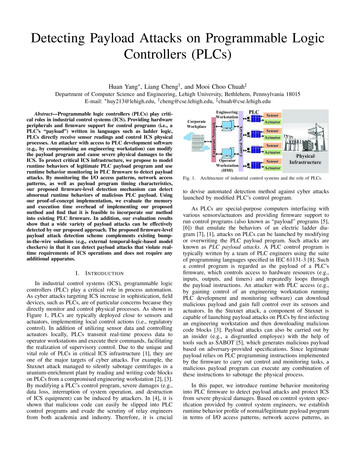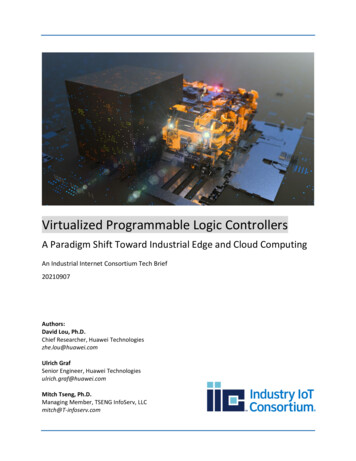
Transcription
Virtualized Programmable Logic ControllersA Paradigm Shift Toward Industrial Edge and Cloud ComputingAn Industrial Internet Consortium Tech Brief20210907Authors:David Lou, Ph.D.Chief Researcher, Huawei Technologieszhe.lou@huawei.comUlrich GrafSenior Engineer, Huawei Technologiesulrich.graf@huawei.comMitch Tseng, Ph.D.Managing Member, TSENG InfoServ, LLCmitch@T-infoserv.com
Table of Contents1 The Integrated, Edge-Based Architecture . 32 Implementation Considerations . 43 A Look into the Future . 74 Business Considerations . 75 Related Presentations in IIC . 86 About the Authors . 8Table of FiguresFigure 1-1. The manufacturing industry is adopting Edge Computing for IT/OT convergence . 4Figure 2-1. Automation platform architecture . 72
Most industrial automation applications demand high reliability and availability for controldevices and associated input and output (I/O) elements. The first discrete Programmable LogicController by Modicon (now Schneider Electric) was introduced in 1968 and Allen-Bradley, in1971, coined the term PLC. Since then PLCs have been widely adopted as the means of control inproduction lines in the manufacturing industry. Although they generally employ an array of PLCsto execute I/O controls precisely, each PLC needs communication ports and a controller unit,making it bulky and expensive. It is also expensive to update programs once deployed.Virtualized PLCs (vPLCs) on commercial-off-the-shelf (COTS) infrastructure can replace a largenumber of individual controller “boxes” and their electronics. This is edge computing, where ITcloud infrastructure is located close to the machines on the shop floor. This makes it possible tomeet the stringent requirements of very low latency and short control cycles. In this paper weassume that the edge computing infrastructure is located on premise, within the factory or plant.This enables a paradigm shift, interconnecting a large number of vPLCs on an edge node toimprove operational efficiency. Although vPLCs have been only adopted sporadically today, thisarchitecture could gain importance with the advent of edge computing. In data centers,virtualization of databases and applications on powerful servers have long been state of the art.Virtualization is the ability to separate logical functions (software) from the physical device andto run on commodity hardware Virtualization has reduced costs, increased flexibility andscalability, and improved reliability and performance in IT. Over the past decade, we have seenmany vendors supporting their supervisory control and data acquisition (SCADA) and distributedcontrol system (DCS) platforms within a virtualized environment, leading to more virtualizationin OT environments.More recently, we have seen a number of DCS vendors deploy virtualized controller CPUs insituations when they need to increase performance beyond the capabilities of their current lineof controllers and to reduce the cost of controllers for strategic accounts. These virtualized DCScontrollers run on commodity IT hardware such as Windows or Linux servers.1 THE INTEGRATED, EDGE-BASED ARCHITECTUREThe following situation is conceivable: discrete PLCs are removed from the shop floor and theircontrol functions are hosted in an edge data center in the form of vPLCs, with suitable computingcapacities and network connection to the automation system. Servers can already processhundreds of vPLCs at the same time, but standard IT servers with virtualization and sharedresources for network and storage cannot adequately address OT industry requirements forreliability and real-time behaviors. For this, industrial edge servers are required that are able torun real-time workloads. Only the I/O stays local to the machines, sensors, actuators and drives.Some examples of industrial workloads including real-time control are shown in Figure 1-1. Themanufacturing industry is adopting Edge Computing for IT/OT convergence3
Figure 1-1. The manufacturing industry is adopting Edge Computing for IT/OT convergenceWith no functional changes, an integrated architecture dramatically decreases capital andoperational expenditures compared to a decentralized architecture based on individual PLCs,since a large number of virtualized PLCs can be hosted on a single server.A clear difference between vPLCs and conventional PLCs can be seen in the flexibility andexpandability. By virtualizing control functions and running them in the edge data center,interactions between virtual controllers become simpler. The communication among virtualcontrollers can be implemented by functional calls within a single server, which increasesreliability and scalability compared with the traditional communication between physicallyseparated PLCs. It dramatically facilitates update and re-design of the production line. Withvirtual control functions running in the data center, it behaves as a “digital twin” of theproduction line, which helps to simulate and predict the behavior of the physical counterpart.The possibility of accessing the data from the field level in the edge data center means thatcontrols and data analytics can be carried out in real-time, which is ideal for diagnostics,maintenance, optimization and intelligent reactions to changes in the automation system. Thebig data analysis doesn’t run “on” but “parallel to” the controls on the same edge servers.Therefore, modern AI and machine learning algorithms could be applied here without interferingwith the existing control process. Since the control functions are to be hosted on the same edgeinfrastructure, feedback loops from data analytics to the control can also be implemented here,thus opening up new optimization options.2 IMPLEMENTATION CONSIDERATIONSWhy is this architecture not (yet) prevalent? Surveys have identified four arguments:4
1. The current architecture is tried and tested: The cost advantages, flexibility andoptimization are desirable, but the gains are not worth it. “Never touch a running system”except when there are significant gains in capital and operational expenditures.2. Service-level agreement and liability: The factory and plant operators bought a “closed”solution from the vendor or system integrator. This often has closed interfaces, so themachine cannot be adapted to a different control architecture. If the machine is notworking as expected, the vendor or system integrator must fix it.3. Technological risks: The reliability and determinism of integrated server platforms are nottrustworthy enough to outsource critical control functions to them. The response time ofcontrollers in an edge data center may also be unreliable due to the network.4. Organizational hurdles: To implement an integrated platform of this kind, the controlspecialists need new skills. The distribution of competencies in the company is oftenincompatible with an integrated architecture.The advantages of virtualization of control at the edge must be judged for each application. Edgecomputing infrastructure is particularly worthwhile for applications that place high demands onflexible production processes and reactive process changes as part of an Industry 4.0 strategy(batch size one).The technological risks are quite challenging, but some recent developments show what isalready possible here:The advantages of virtualizing the control at the industrial edge must be judged for eachapplication. In real-time data acquisition and edge analytics, advantages can be found inapplications that rely more on flexible production processes and reactive process changes as partof an Industry 4.0 strategy (batch size one). Because of its flexibility, an edge computinginfrastructure is particularly worthwhile for applications that place high demands on dynamicchanges in automation. The technological risks are quite challenging, but some recentdevelopments show what is already possible here: Real-time operation systems and hypervisor solutions already offer mechanisms forguaranteed robust partitioning of resources such as CPU cores and cache for currentmulticore CPUs, so that instead of virtualization and the associated runtime fluctuations,real-time performance like 'bare metal' can be achieved. The more cores, the more realtime applications can be run simultaneously and independently of one another.Hardware-supported network virtualization of the local Ethernet interface(s) enablesseveral applications to use the network resources on the same server independently ofone another and required bandwidth in the network is available in real time. TimeSensitive Networking (TSN) and Deterministic IP provide the mechanisms in the networkto transport real-time data from different applications independently and withoutinterference with guaranteed latency through an Ethernet network.5
For various fieldbus protocols such as Ethercat and Profinet, specifications are alreadyavailable to define 'tunneling' via TSN. This enables I/O at the field level to communicatewith the vPLCs in the edge data center through one network, as if they were directlyconnected via the fieldbus.There is a strong trend towards manufacturer-independent interfaces for application andmanagement. The current specification work in the Motion Working Group of the OPCFoundation aims to ensure vendor-independent interoperability between controls andmotion control devices (drives, I/O) based on OPC UA Publish/Subscribe. Similarstandards for manufacturer-independent interoperability based on OPC UA and TSN havealready been adopted by other industrial consortia and associations (e.g. Euromap andOPAF). Manufacturer-independent management interfaces may also play a role.With these mechanisms, technologies and standards, the integrated and edge-basedarchitecture can be implemented, as it already is in various test beds and demonstrators.Nothing changes in the model of the control with regard to programming and runtime behavior:The IEC 61131 programming model can be used unchanged, even if the resulting controlapplication is implemented as a virtualized PLC and only communicates with the field level viafieldbus interfaces. Meanwhile individual developments are already aimed at expanding theintegrated architecture in accordance with the requirements of IEC/EN 61499 for distributedcontrols, e.g. https://www.eclipse.org/4diac/ and https://www.nxtcontrol.com/en/.Finally, the organizational challenges are non-negligible. The configuration, commissioning andmaintenance of an edge platform for hosting of controls is a completely different task fromprogramming and operation of a PLC. Therefore, the lifecycle of the control applications remainsthe domain of the experts for these applications as before, while the IT department takes care ofthe installation and maintenance of the edge servers and the hosting infrastructure running onthem. The essential interfaces, which ensure robustness and determinism in accordance with therequirements of the automation industry, must be contained in a correspondingly certified edgecomputing platform product, because this competence is usually neither with the experts forcontrols nor in an IT department.But this does not change anything in the basic model. Figure 2-1shows the potential architectureof a hypothetical automation platform.6
Figure 2-1. Automation platform architecture3 A LOOK INTO THE FUTUREA consistently integrated edge-based architecture for controls in automation is currently notstate of the art. The current architecture, in which most controllers are implemented directly inits application as a hardware PLC, is well established. However, if there is a need for moreflexibility, the methods and technologies for integrating the virtualized controls in an edgecomputing architecture with edge nodes and edge data centers can offer great benefits.Certainly, there are challenges ahead for full PLC virtualization to become a reality. For example,there are fundamental differences between the deterministic nature of PLCs and theundeterministic, performance-focused nature of other traditional cloud services, e.g. officeapplications. Full PLC virtualization is unlikely to occur without one or more vendors gettinginvolved in this technology shift. The vendors that create this reality would have greater marketinfluence as the “VMWare of OT.”4 BUSINESS CONSIDERATIONSAlthough using virtual PLCs in industrial control opens up an opportunity to integrate all theadvancements in ICT technologies developed recently, the adoption rate in the manufacturingindustry can be improved. We recommend vPLCs be deployed for greenfield deployment. To getthe maximum benefit, they should be integrated with actuators and sensors on the productionline, and make the controller-with-vPLCs be part of the Smart Factory supporting subsystems.7
Huawei is currently performing proof-of-concept validation in the process industry and in factoryautomation. Some promising results can be found in a paper we published together with 2019/1570581161.pdf5 RELATED PRESENTATIONS IN IIC“Deterministic IP enabling virtualized PLC at the Edge”, IIC Innovation TG, July 28th document/previewpdf/222016 ABOUT THE AUTHORSThe views expressed in this IIC Technical Brief are the contributing authors’ views and do notnecessarily represent the views of their respective employers nor those of the Industry IoTConsortium.David Lou graduated as Ph.D. in Electronic Engineering at GhentUniversity in 2005. In the same year he joined the Alcatel-Lucent BellLabs as an Innovation Researcher. He had a leading involvement andmanagement role in several European and national research projects(Giant, Smart Touch, Metaverse1, Mistra, Shift-TV, etc.), andstandardization bodies (MPEG). In 2016 he joined Huawei Technologiesas a Chief Researcher based in Munich, Germany. He is responsible fordefining the research strategy, steering disruptive network innovation and coordinatingcollaboration with industrial and academic partners. He is also leading the standardizationactivities in various SDOs (e.g. ITU-T, IETF, ETSI, etc.) His interests mainly covers IoT/IIoT/I4.0,next generation industrial networking architecture, deterministic communication, networkprivacy, video streaming and transportation, and immersive communication. He is the co-chairof the IIC Networking Task Group and has been actively involved in relevant industrialdevelopment activities. He has (co-) authored more than 30 scientific publications and whitepapers. He has been granted with more than 20 patents.Ulrich Graf holds a diploma degree in Electrical and ElectronicEngineering (1994). Before joining Huawei in 2011 he worked almost 17years in the telecommunication industry in various sales, product andR&D departments at Siemens and Nokia where he could extend hisbusiness & professional competence in the areas of Engineering,Product- and Program-Management for enterprise, fixed and mobilenetworks. Since joining Huawei Ulrich was established in the EuropeanSolution Management Team serving solutions like Policy/TrafficManagement, Cell Congestion Control, Telco Transformation (SDN/NFV/MANO), IoT and8
Industry4.0. In 2019 he joined the Applied Network Technology Laboratory in the HuaweiGerman Research Center in Munich working on new communication and networkingtechnologies targeting different industry verticals.Dr. Mitch Tseng is a well-known veteran in the international standardscommunity for communications. He had been leading the developmentof various telecommunication standards in TIA, 3GPP2, 3GPP, andhelped established oneM2M prior to joining the Industry IoTConsortium (IIC). His latest passion is to promote technologies such asEdge Computing, Digital Twin, AR/XR, Li-Fi and AI for Industrial IoT (IIoT)Services. He is currently the Chair of the Innovation Task Group, theEdge Computing Task Group and the Testbed Council in IIC. In additionto the IIC work, Mitch is the Rapporteur of ISO TC204 WG16 (ITSCommunication Protocols).As a self-proclaimed IIoT Evangelist, he has been visiting end-users in different trades to listenand learn the Do’s and Don’ts about the practices from them, so as to help refine therequirements for IIoT Services. Leveraging IIC as a vehicle, Dr. Tseng is also engaging in connectingmembers and outside partners to build a healthy IIoT micro-ecosystem. With all the meetingsamong interested parties in Asia, Europe, and Americas, Mitch’s next milestone, literally, is tobecome a Four-Million-Miler of American Airline’s Advantage Program.Copyright 2021, Industry IoT Consortium, a program of the Object Management Group . Allcopying, distribution and use are subject to the limited License, Permission, Disclaimer and otherterms stated in the Industry IoT Consortium Use of Information – Terms, Conditions & Notices,as posted at https://www.iiconsortium.org/legal/index.htm#use info. If you do not accept theseTerms, you are not permitted to use the document.9
Virtualized Programmable Logic Controllers A Paradigm Shift Toward Industrial Edge and Cloud Computing An Industrial Internet Consortium Tech Brief 20210907 Authors: David Lou, Ph.D. Chief Researcher, Huawei Technologies zhe.lou@huawei.com Ulrich Graf Senior Engineer, Huaw
